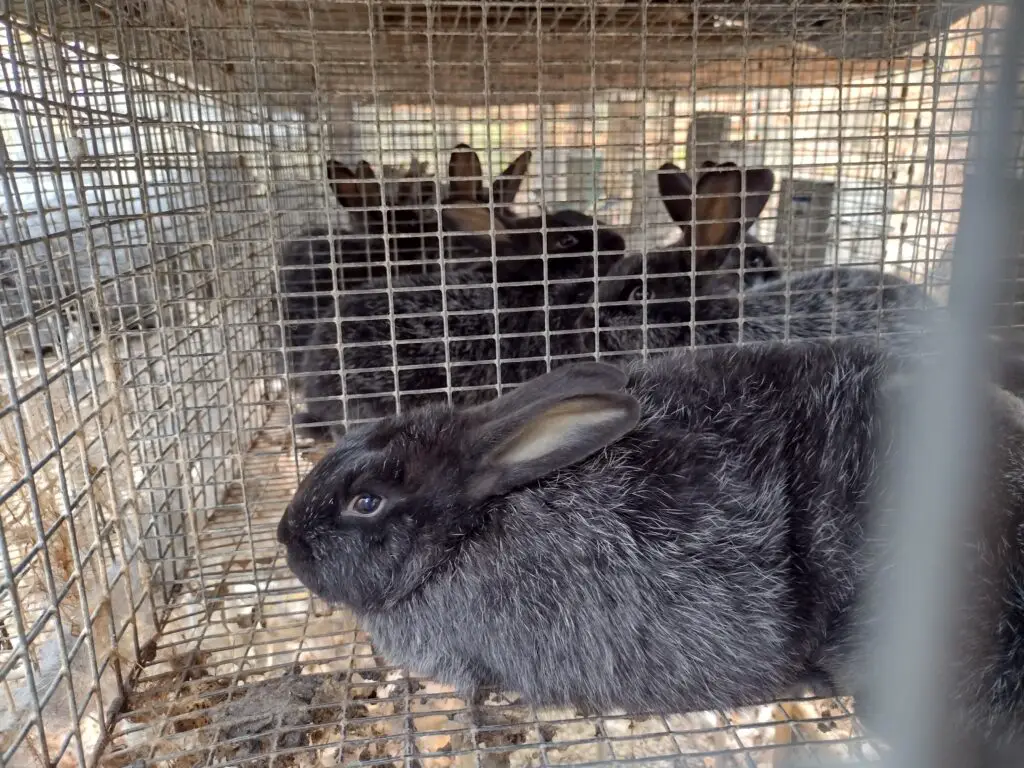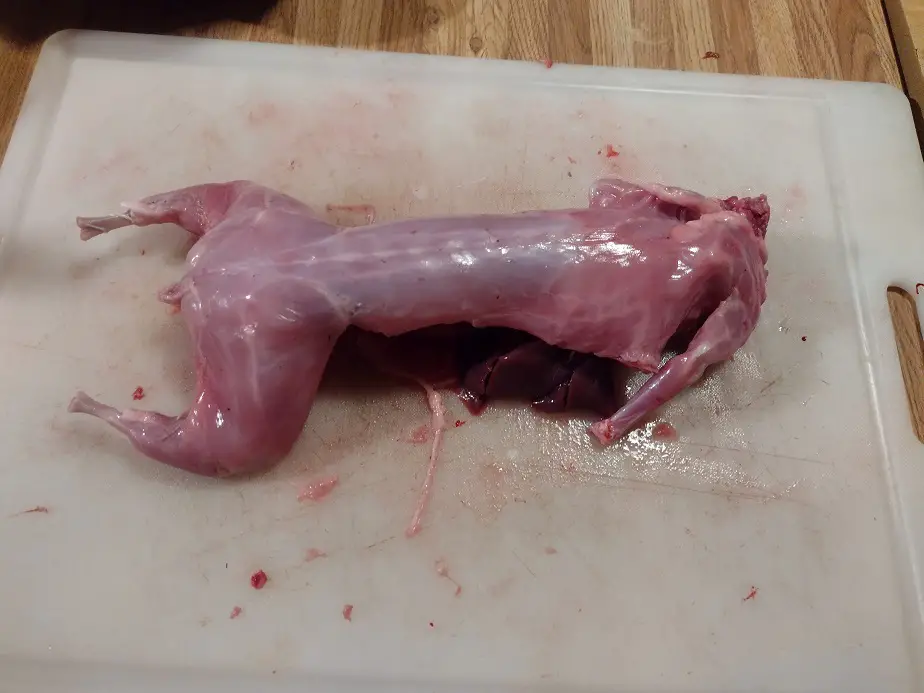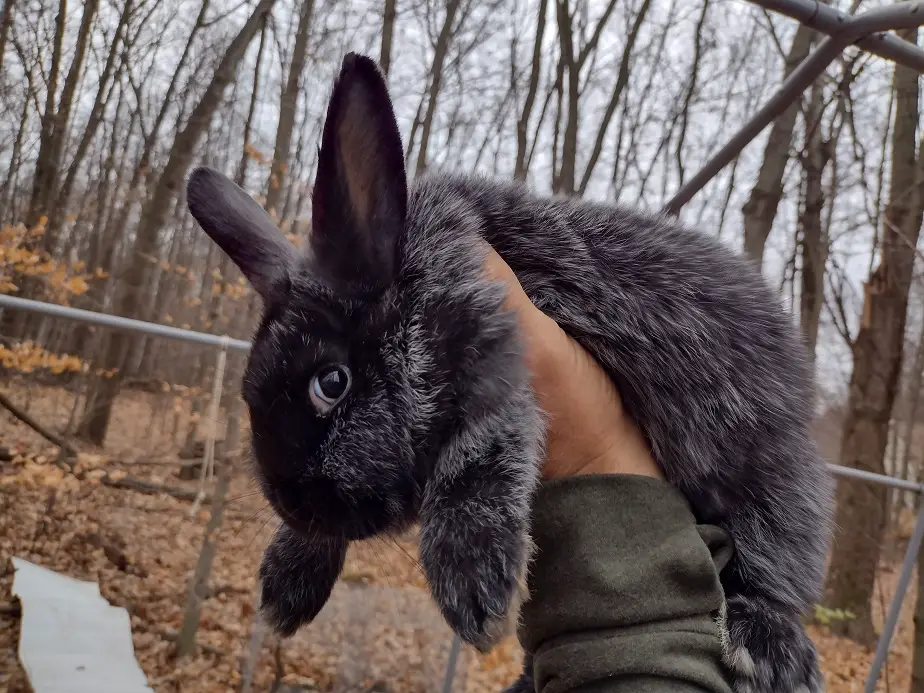We’re raising and butchering a few hundred meat rabbits a year. This is what I’ve learned.
Meat rabbits 8 to 12 weeks to reach butcher size in decent raising conditions. Genetics, breed, feed quality, and stress will cause the time frame to fluctuate some. Most commercial rabbitries butcher at 8 to 10 weeks, but some small operations raise them for 16 or 18 weeks for a larger carcass.
I’m going to take you through a bit of the science involved, then help you make a custom-tailored decision for your animals.
When Should You Butcher Rabbits?
Most people only look at an animal’s sizer to determine if it’s butcher ready, but the animal’s age is a more important metric. As they grow, they become less efficient users of feed. I do not go by weight for any of my animals, ever. It’s not a good idea.
Animals’ feed efficiency is rated in two things, the Feed Conversion Ratio (pounds of feed per pound gained), and the Feed to Yield Ratio (pounds of feed per pound of meat in the freezer). You need both to know if things are working well.
The Feed Conversion Ratio is measurable while the animal is alive, and tells you the age at which an animal is consuming too much feed to be worth it anymore. When a rabbit, or any animal, is born, they have the best Feed Conversion Ratio. Every day after, it lessens some.
There are two functions of feed, body maintenance, and growth. In rabbits, growth takes approximately 2.5 pounds per pound gained, regardless of age. However, the amount of feed for body maintenance increases with the size of the animal. So, older animals, even if they are still growing, are less efficient.
An 8-week and 16-week-old rabbit has the same growth needs, but the older rabbit has greater maintenance needs and thus eats more feed per pound gained. The older rabbit would have a higher Feed Conversion Ratio. Tracking the ratio is handy, but it’s even more important to understand this.
I only really look at the Feed to Yield Ratio. I find it a better metric of whether or not my feeding and raising methods are working. Plus, it’s easier to weigh a carcass than a live animal.
I used to wait until my rabbits were at 5 pounds live weight because that’s what most people recommended. Now, I only care about age. I used to butcher at 12 or 13 weeks, when they were close to 5 pounds. Now I’m butchering at 8 or 10 weeks.
I find that efficiency is better than reaching a certain weight. There is a commercial standard in the US of 5 pounds live weight, and 2.5 to 3 pounds butchered. That’s not necessarily the most efficient model. Different breeds and different lines of rabbits are different-sized. There’s not a “perfect weight” to hit.
If you really want a 5-pound rabbit carcass to fill the crockpot, you’re going to pay dearly for it in feed.

How to Cull Rabbits for Better Breeding Stock
The 5-pound thing is just that it yields a carcass that’s big enough for a small family. And that’s nice, but the way to get 5 pounds is through monitoring and controlling your breeders. We do that mainly by culling and replacing the one do that consistently produces the smallest bunnies.
Keep records of which do had which litter, and keep the litter separate. When you butcher, butcher one litter at a time. After you dispatch a rabbit, weigh it. Write it down. Then weigh the carcass when you’re done and write that down. Do this for each butchered Animal.
When it’s all cleaned up, go and calculate the yield by percentage; that is the percent of body weight remaining after butchering. Litter average yield percentage is the first culling factor. Litter average carcass weight is the second. After a few litters, look at the numbers and determine which doe needs replacing.
Replace the animal with the finest specimen from one of the best performing does. If you do this twice a year, you’ll end up with some really nice animals.
Other lesser points to consider for culling meat rabbits are the number of bunnies per litter, coat color and texture, carcass fat content, and behavior.
Other more important factors are health issues, poor mothering instincts, high mortality rate of bunnies, and teeth or toenails that grow too fast.
If you want to butcher rabbits with the best coat of fur, then you do need to let them get older. Their fur quality significantly improves in fullness and length between 15 and 16 weeks. It’s generally unprofitable to keep them much longer, but fur quality can continue to increase until 24 weeks (6 months).
The issue with keeping rabbits for the furs is that fur isn’t popular anymore. Some rabbits, like Satins and Silver fox, have furs that used to demand a high price. But now, it’s hard to sell them at all. It’s a shame really. Fur is an amazing renewable resource, and it’s darn warm.
What to Do if All Your Rabbits are Butchering Small?

The main two reasons for significantly undersized rabbits are poor quality feed and stress. Feeding rabbits mostly grass or wild fodder tends to produce leaner, smaller-bodied rabbits. If rabbits aren’t getting enough protein or calories overall, they will be undersized. Protein is usually the bigger deal.
Growing rabbits should usually get between 15 and 18 percent protein for optimum growth. Some rabbit owners feed a 20 percent protein feed to growing bunnies, but I consider that a waste. I just don’t see gains by upping the protein that high. I am happy with a 16 percent protein feed.
Now, we do raise quite a few litters up on grasses and wild fodder. They will be small, but the feed bill will be smaller. It’s just something to expect. If you are raising rabbits on pasture alone, they are probably going to be noticeably under-sized.
This fall, I’m planting 1/8 to 1/4 acre of alfalfa ( 16-18 percent protein) to feed the rabbits. We’re working to increase the number of rabbits we produce, but lower the feed bill.
Related Articles:

